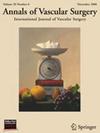Use of Suboptimal Great Saphenous Vein in Lower-Extremity Bypass Yields Favorable Amputation-Free Survival
IF 1.4
4区 医学
Q3 PERIPHERAL VASCULAR DISEASE
引用次数: 0
Abstract
Background
Historically, studies have identified a great saphenous vein (GSV) diameter of at least 3.0 mm for optimal durability following lower-extremity bypass. With the recent publication of BEST-CLI and BASIL-2 studies, we sought to compare patency and postoperative complications utilizing GSV conduit of <3.0 mm to veins ≥3.0 mm or alternative conduits from a single institution.
Methods
Patients with preoperative GSV vein mapping in an Intersocietal Accreditation Commission accredited vascular lab who underwent infrainguinal bypass surgery at a tertiary center were included. Vascular lab software was utilized to compare patient median GSV across at least 6 anatomic locations. Patients were separated and stratified based on median GSV size (both overall and limited to above- or below-knee GSV). Primary outcomes included postoperative complications, 30-day major adverse limb events, major adverse cardiac events, and patency at regular follow-up intervals.
Results
From January 2016 to February 2022, 178 patients underwent bypass with preoperative vein mapping: 82 who received GSV<3.0 mm and 96 who received GSV≥3.0 mm. Patients were evenly distributed in demographics including proximal and distal targets. Median follow-up was 1.90 years. Overall, use of <3.0 mm GSV was not associated with inferior 1-year primary patency compared to ≥3.0 GSV (82.1 vs. 89.4%); however, there was a significant increase in postoperative creatinine unique to patients with GSV<3.0 mm alone (8.5% vs. 1.1%, P = 0.026). There were no differences in 30-day major adverse cardiac event or major adverse limb event between groups. In surveillance up to 3 years, patients who received GSV≥3.0 mm versus GSV<3.0 mm conduits had similar reintervention and amputation-free survival rates (P = 0.999).
Conclusion
Patients who received GSV bypasses <3.0 mm have the same mid-term patency, reintervention rates, and amputation-free survival as patients who received GSV≥3.0 mm. Use of smaller GSVs may require closer follow-up for acute kidney injury. Nonetheless, under appropriate circumstances, suboptimal GSV can be utilized for lower-extremity arterial bypass.
求助全文
约1分钟内获得全文
求助全文
来源期刊
CiteScore
3.00
自引率
13.30%
发文量
603
审稿时长
50 days
期刊介绍:
Annals of Vascular Surgery, published eight times a year, invites original manuscripts reporting clinical and experimental work in vascular surgery for peer review. Articles may be submitted for the following sections of the journal:
Clinical Research (reports of clinical series, new drug or medical device trials)
Basic Science Research (new investigations, experimental work)
Case Reports (reports on a limited series of patients)
General Reviews (scholarly review of the existing literature on a relevant topic)
Developments in Endovascular and Endoscopic Surgery
Selected Techniques (technical maneuvers)
Historical Notes (interesting vignettes from the early days of vascular surgery)
Editorials/Correspondence

 求助内容:
求助内容: 应助结果提醒方式:
应助结果提醒方式:


